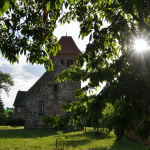Hohenseefeld, Brandenburg, Germany
Hohenseefeld with its some 400 inhabitants was created in 1952 through the merging of the villages Niederseefeld and Hohenseefeld, which were separated by a trench that also used to separate the states Saxony and Prussia. Hones is one of 23 parts of the municipality Niederer Fläming. The closest center, the city Jüterborg, is 24 kilometres away, Potsdam 85 kilometres and Berlin around 100 kilometres.
The population has been decreasing since 2001, which results in the focus of settlement development being put on the maintenance of the two village cores, avoiding vacancy and filling gaps in the construction system. The mostly old and added new constructions create a harmonic unit.
From an economic stance, Hohenseefeld rests on two pillars – local food production for Potsdam and renewable energy, particularly wind energy. Originally there were no squires, only free farmers with their four-walled farms, many of which are still in existence and were restored, although most businesses were collective during GDR-times. Today, agricultural spaces are used by a local agriculture business and two agricultural associations. Within the municipality Niederer Fläming are 28 wind turbines, seven more are planned. the spacial planning of the municipality will shortly be approved in order to create new wind parks.
Within the village there are also 40 smaller and bigger enterprises, the female activity is exceptionally high. Public transport is well organized, a system of call busses adds to the mobility. The social infrastructure with day care center, nature kindergarten, social station, physical therapy and dentist is good. All schools are within a distance of 25 kilometres and publicly reachable.
The German reunification had a major impact on the social structure and resulted in a wave of emigration. Only recently the quality of life within the village was rediscovered. Instigator for this was the decision to participate in the county harvest festival and the competition “Our Village Has A Future”: strengths and weaknesses were analysed, development potentials were identified. Even though there is no explicit guide line, project plans are defined in a climate protection and energy concept. These have partly been implemented already, others are still being planned. They include sustainable energy and environmentally friendly mobility (E-mobility, car-sharing), measures in the field of village and green space modelling, ensuring medical and other local services (village store, physical vessel therapy) and the creation of communal hotspots and leisure time activities (village square with a family and generations center, remodelling of the gym).
The communal togetherness is important both during the implementation of these projects and in daily life. Finding a balance between openness for new things and the maintenance of traditions is a goal in the process. The high amount of voluntary commitment is outstanding, often organised in one of the 14 clubs and associations, and it is what makes the implementation of many measures possible in the first place.
Evaluated: 2016






